| 1 | The 3rd deadliest land snake |
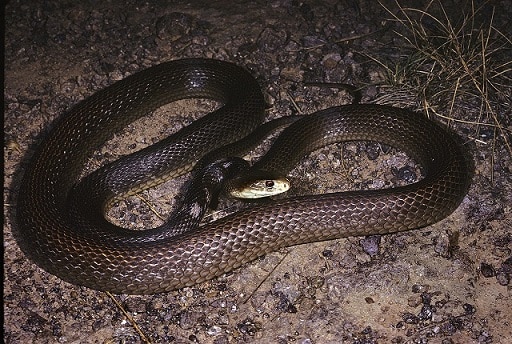
The coastal taipan is a species of northern Australia, occupying the entire coastline from Queensland to Northern Territory. It’s the cousin of the inland taipan, the most venomous land snake in the world, but is easily the more common of the two.
While inland taipans stick to isolated desert clay cracks, and are barely seen by the average Australian, the coastal taipan prefers areas of higher rainfall. This commonly brings them into contact with humanity, in a variety of habitats ranging from dry woodlands, to monsoon forests, football pitches, picnic areas, and grassy plains, sending terrified people scattering as they rear up their chests and hiss.
The coastal taipan is less venomous than its cousin, but still has the third most potent venom of any land snake (behind the eastern brown snake). This is a fast-moving and alert species, which is constantly raising its head to scan the horizon. Back in the 1800s, when Australia was still an uncharted mystery, Queensland Aboriginals often spoke of monster serpents they waged war against. The coastal taipan is a likely candidate, as it reaches 2 metres with ease, with rumours of up to 3.2 metres.
| 2 | Neurotoxic to the extreme |

Between 2005 and 2015, coastal taipans dealt out 4% (31 bites) of identified snakebite cases in Australia. Like the inland taipan, their venom is powerfully neurotoxic, hijacking the brain while leaving little more than a pair of puncture marks at the bite site.
General symptoms include nausea and vomiting, which can progress to drooping eyelids, limb weakness, and paralysis. In the worst cases, the lungs cease to inflate and the patient must be placed on a ventilator. Antivenom was developed in the 1950s, but a handful of people have died since 1980.
One case happened on August 13th 1990, to a 42 year old camper who attempted to whack an intrusive snake with a shovel. He was bitten in the process, and dispatched the taipan with a shotgun, before wrapping a bandage around his arm. At the hospital three hours later, he complained of feeling drowsy, thirsty and having a sore throat. He was deathly pale, and soon developed fixed, dilated pupils (also reported for inland taipans) and breathing difficulties. The nurses administered antivenom, but he died, less than 6 hours post bite.
| 3 | Comparison: inland taipan |
The inland taipan’s LD50 rating is 0.025mg, the highest on Earth, which defeats the coastal taipan at LD50 0.1mg. However, the coastal taipan has a slightly higher venom yield, of 120mg per bite versus 71-120mg. Additionally, coastal taipans produce far more pre-synaptic neurotoxins, which are more difficult to treat with antivenom than post-synaptic neurotoxins. Acetylcholine is a major neurotransmitter in humans, and post-synaptic neurotoxins prevent it from binding to receptors in muscle cells, for instance. But pre-synaptic neurotoxins block the release of acetylcholine in the first place.
The inland taipan has vastly more post-synaptic neurotoxins, making up 50.2% of the venom versus only 5.8%. But the coastal taipan consists of 56.6% presynaptic neurotoxins, versus the inland taipan’s 31.8% (with the precise figures varying by region).
One particular presynaptic neurotoxin in coastal taipan venom is taipoxin. This is considered to be the most potent neurotoxin in the entire snake kingdom, and is responsible for the venom’s respiratory paralysis. Our final message: never underestimate the coastal taipan.
| 4 | ID: check for the pale face |
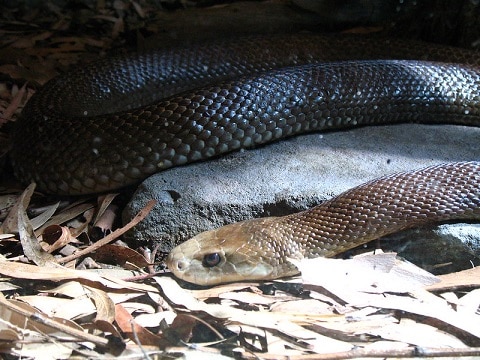
The coastal taipan is long and brown and easily confused with other snakes. The signature sign of this Australian killer is its pale head and snout, which contrasts sharply against the rest of their dark body. Coastal taipans darken with age, even the head, but the snout keeps its pale colour for as long as they live. This pale face is a great way to distinguish them not only from inland taipans (which are consistently dark), but also eastern brown snakes. Fortunately, misidentification won’t be too costly, as you should stay well away from all three.
The coastal taipan is something of a chameleon, as their colour also varies by season, lightening during the summer. Their bodies are mostly smooth to touch, with the exception of the neck. Their belly colour ranges from yellow to pale orange, but is never as vivid as the red-bellied black snake, which they coincide with.
The confirmed record for the coastal taipan is 2.9 metres, which makes it the second longest venomous snake in Australia after the mulga. Other ways to separate them from inland taipans are their red eyes (brown for the inland) and longer fangs of 13mg versus 6mg, which hopefully you’ll never get a chance to see…
| 5 | Australia’s top mammal eater |
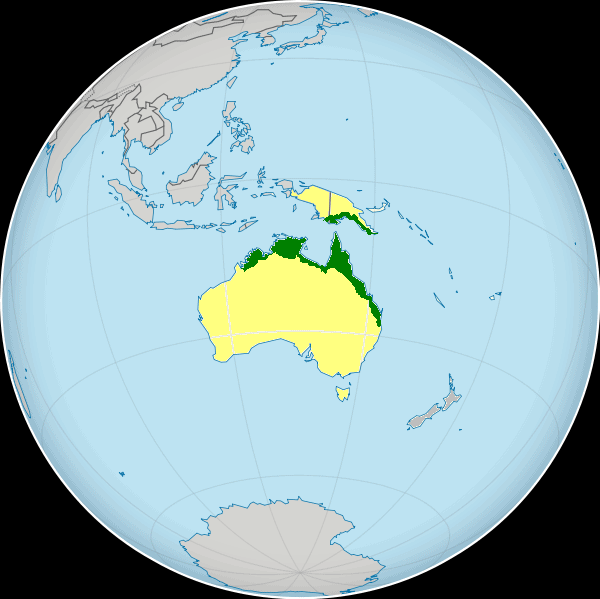
Nature wasn’t picking characteristics out of a hat when it made the coastal taipan. The jumbo length, the paralysing venom, and the swift speed, they all go to one purpose – eating mammals that could easily claw back at them.
The coastal taipan is the most exclusively mammal-eating snake in the whole of Australia, joint with the inland taipan. Mammals made up 18 of 19 prey identified in a study on wild coastal taipans, with just 1 bird. The top two species were the house mouse and long-nosed bandicoot. Others included the dusky field rat, grassland mosaic-tailed rat, and pale field rat. The only Australian species that comes close to the taipans for mammal consumption is the rough-scaled snake, which averages at 48% mammals.
With no taste for amphibians, the coastal taipan has the pleasure of being immune to the cane toad, a highly toxic invasive species which has wreaked havoc on death adders and eastern brown snakes. Coastal taipan numbers have actually increased in Australia since 1941.
| 6 | Strangely similar to the black mamba |
A coastal taipan on the prowl usually travels with its head raised above ground level. After detecting a mammal, the coastal taipan suddenly freezes, before delivering a succession of rapid stabbing strikes.
They then release their prey instantly, as rats possess sharp, gnawing teeth which could easily pierce the taipan’s respectable yet flimsy scales. This is no joke; a 1981 book reported how a rat managed to kill a coastal taipan within seconds, as the snake hung on for a moment too long. Instead, the coastal taipan follows patiently behind a staggering rodent, waiting for the venom to spread through every last vein and capillary. The finely tuned neurotoxins can kill within minutes.
In many separate ecosystems, two unrelated animals will take up virtually identical roles. For example, the puff adder of Africa and death adder of Australia are both obese-looking venomous snakes that wait motionless by game trails. In Africa, the parallel species of the coastal taipan is considered to be the black mamba. The two are fast, thin, venomous, agile and largely prey on mammals, with a small helping of birds.
| 7 | Often found in sugar plantations |

Another reason behind the coastal taipan takeover is the spread of Australia’s sugar plantations. The industry kicked off in the 1800s, fuelled by migrant workers, and expanded rapidly in the 1930s. Nowadays, Australia is the second largest producer of raw cane sugar worldwide, with Queensland being the capital.
Something about these sugar plantations draws in coastal taipans like a magnet, whether it’s the dense crops interspersed with open patches, or the scores of tasty rodents lurking there. Costal taipans are abundant in crop plantations, despite the dangers of modern mechanised machinery. They even mate in these sugar fields, nobly creating the next coastal taipan generation. They use the same spots year after year, as scientists observed in one sugar field near Silkwood, 120km south of Cairns.
In the 1950s, the sugar connection grew so strong that manual workers were reluctant to sign up, for fear of the taipan bogeyman rustling in the bushes. The sugar industry hastily paid snake guru Ram Chandra to tour Queensland, and the Queensland Cane Growers’ Council published an article explaining that taipans were actually shy.
| 8 | The antivenom origin story |
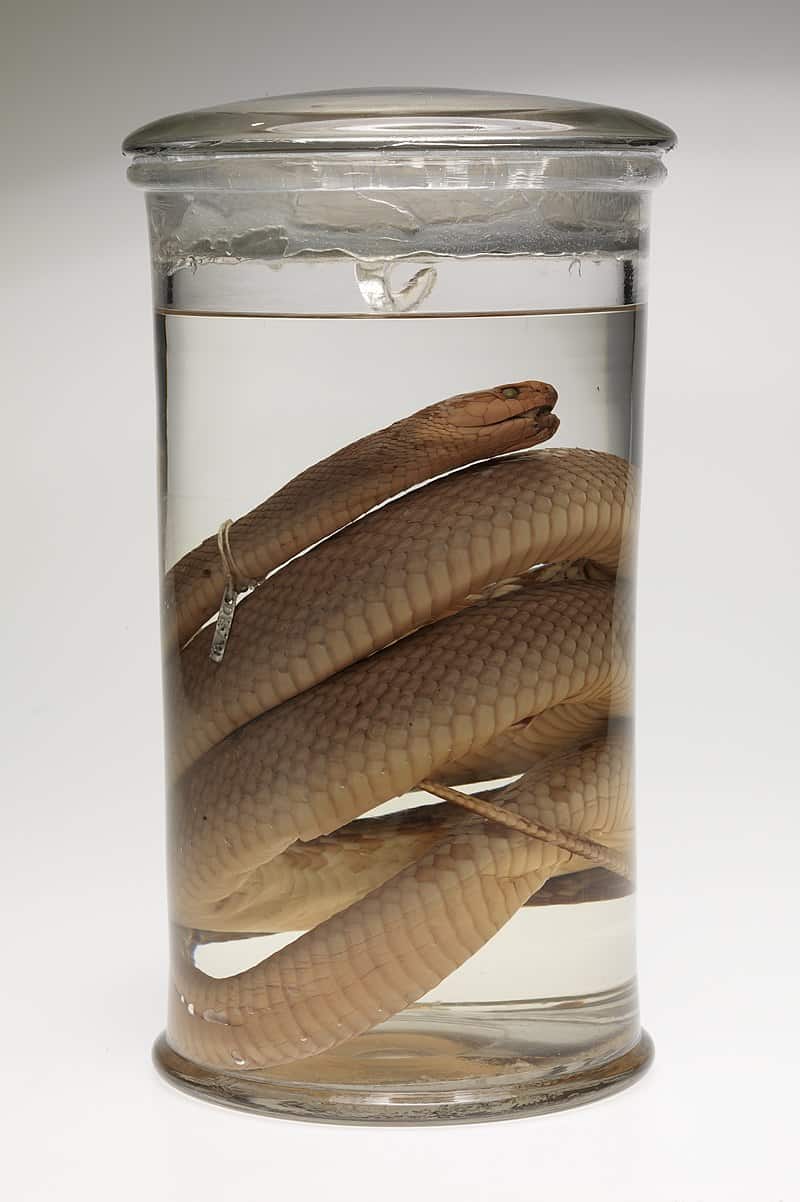
George Budden was a 20 year old snake fanatic who had spent four weeks hunting for a coastal taipan, in Australia’s poorly charted north. On July 28th 1950, after picking up 27 snakes, he finally found one lurking in a rubbish dump, about to eat a rat.
Unable to force it into a sack, Budden flagged down a passing truck, with the 2 metre taipan grasped firmly in his hand by the neck. The brave truck driver agreed to drive him to his snake catcher friend, but when they pulled up, Budden’s clenched hand was sweaty and weakened. The taipan broke free, and in the melee it managed to bite Budden on the foot, before fastening onto his hand. The catcher moved to kill the taipan right then, but Budden insisted that it be spared. Budden was taken to hospital, but with antivenom only available via time machine, he died the next day.
Fortunately for Australia, Budden’s last wish was honoured. The taipan became a minor celebrity, before dying itself 4 weeks later. But most importantly, 78mg of milky white venom was extracted from its vicious fangs, and using this batch, acquired with great loss, scientists developed the very first coastal taipan antivenom. The dead snake was preserved (see its picture above).
| 9 | Tales from the hellish north |
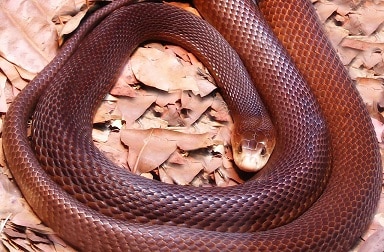
The hellish northern realms were a place that civilised Sydney feared back in the day. Tales spread in the 1930s of coastal taipans dropping out of trees and landing on victims’ heads, and naturalist Charles Barrett wrote of a coastal taipan that stalked him for 2 hours before being dispatched with a brush hook. The dawn of antivenom came in mid-1955, with the first recipient being 10 year old George Stringer, who was bitten in a school south of Cairns.
Meanwhile, Ram Chandra was a snake enthusiast regarded as an eccentric amateur by the government. Annoyed at the lack of support, he vowed in March 1955 to make an antivenom himself. Chandra convinced a local doctor to carry out a test on him personally. Hesitantly, the cautious doctor wondered whether they should use a kangaroo rat instead. Chandra reluctantly agreed, and good thing he did, because his home made elixir didn’t do a thing to save the rat from taipan-induced death. A local police officer then arrived at the doctor’s office on post mortem business, and wasn’t amused to find a live coastal taipan slithering all over the floor.
| 10 | 2007: new taipan discovered |
The third taipan species is by far the least known: the central ranges taipan (Oxyuranus temporalis). It was discovered in 2007, when Dr Mark Hutchinson spotted a brown snake crossing a dirt track on a sunny afternoon. It was presumed to be an eastern brown, and the cautious Hutchinson stood well back. He bagged the snake and sent it off to Perth University, where mitochondrial DNA analysis revealed it to be a sister species of the two more common taipans, apparently a genetic cluster that had become separated to the west.
Lab tests reveal that Oxyuranus temporalis is also extremely toxic, scoring 0.075mg on the LD50 scale, albeit less than the inland taipan at 0.025mg. The central ranges taipan had subtle scale differences, and had the same white face as the coastal taipan. It was fresh proof that weird things were still lurking in Australia’s vast outback after all this time.
3 years passed, with no new sightings. Then during an expedition in the Great Victoria Desert in May 2010, the Spinifex aboriginal people stumbled across another. At 130cm, this central ranges taipan was longer than the first, and 425km further south.
